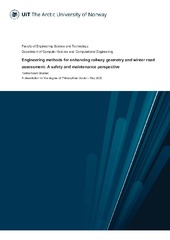Comparison of the Ice Watch Database and Sea Ice Classification from Sentinel-1 Imagery
Permanent link
https://hdl.handle.net/10037/17253Date
2019-12-13Type
Master thesisMastergradsoppgave
Author
Pedersen, Joakim LillehaugAbstract
In this thesis,we investigate the potential use of in-situ sea ice observations from
the Ice Watch database as ground truth data for an automated classification
algorithm of sea ice types from Sentinel-1 SAR data. The Ice Watch database and
the Sentinel-1 data archive are searched for in-situ observations and satellite
data acquisitions in Extra Wide swath mode overlapping in both space and
time. Time differences of up to a maximum of 12 hours are accepted and
included in this investigation. The Sentinel-1 data is downloaded in Ground-
Range Detected format at medium resolution and thermal noise correction,
radiometric calibration and additional multilooking with a 3-by-3 window is
applied. Different ice types in the images are then classified with the Gaussian
IA classifier developed at UiT. The resulting image with ice type labels is geolocated
and aligned with the in-situ observation from the Ice Watch database.
A grid of 25-by-25 pixels around the location of the Ice Watch observation
is extracted. For data points with a large time difference between in-situ
observation and satellite data acquisition, a sea ice drift algorithm is applied
to estimate and correct for possible influence of ice drift between the two
acquisition times. Correlation and linear regression is investigated between a
total number of 123 observation and the classified area around the observation.
In addition, per class accuracy for the trained ice types in the classifier is
investigated. A medium to strong positive correlation is found between types of
ice and a weakly negative to no correlation was found for sea ice concentration.
“Second-/Multiyear ice” separation achieves the highest score with 93.8 % per
class accuracy. The second highest scoring class is “Deformed First-Year Ice”,
for which 48.1 % per class accuracy is achieved. The thinner ice performs
poorly due to the low number of representative of observations from these
classes. Based on the findings there is a relationship between the reported
observations from the Ice Watch database and the classified Sentinel-1 images.
The ability to separate the older and deformed ice types from younger level
ice is present.
Publisher
UiT Norges arktiske universitetUiT The Arctic University of Norway
Metadata
Show full item recordCollections
Copyright 2019 The Author(s)
The following license file are associated with this item:
Except where otherwise noted, this item's license is described as Attribution-NonCommercial-ShareAlike 4.0 International (CC BY-NC-SA 4.0)
Related items
Showing items related by title, author, creator and subject.
-
Engineering methods for enhancing railway geometry and winter road assessment: A safety and maintenance perspective
Brustad, Tanita Fossli (Doctoral thesis; Doktorgradsavhandling, 2020-06-22)In many areas around the world there are limited transportation possibilities when travelling between key cities. If these areas also experience demanding weather conditions or geography, getting from A to B, during difficult conditions, is usually not optimal in regards to accessibility, safety, and comfort. Under challenging conditions, two essential elements in strengthening accessibility, safety, ... -
Geometric Modeling- and Sensor Technology Applications for Engineering Problems
Pedersen, Aleksander (Doctoral thesis; Doktorgradsavhandling, 2020-10-20)In applications for technical problems, Geometric modeling and sensor technology are key in both scientific and industrial development. Simulations and visualization techniques are the next step after defining geometry models and data types. This thesis attempts to combine different aspects of geometric modeling and sensor technology as well as to facilitate simulation and visualization. It includes ... -
Iceberg Drift-Trajectory Modelling and Probability Distributions of the Predictions
Baadshaug, Ole (Master thesis; Mastergradsoppgave, 2018-06-29)Moving icebergs represent a major problem for shipping, as well as for oil and gas installations in ice infested waters. To be able to take actions against hazardous icebergs, it is necessary to develop models for prediction of iceberg drift trajectories. Many models have been developed in order to do so, using different approaches. These approaches can be divided into two main categories, dynamic ...


 English
English norsk
norsk



